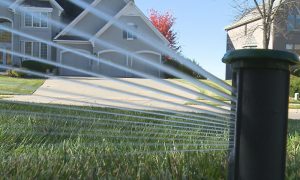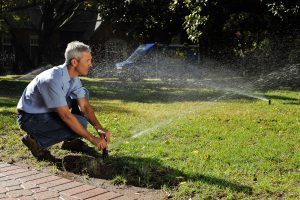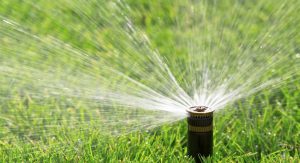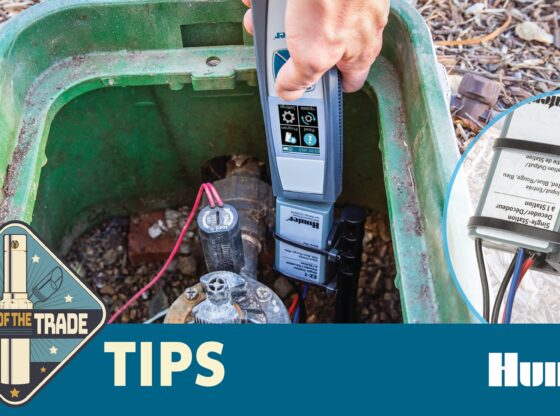Anything from proper equipment selection to creating the most cost effective efficient design. A professional irrigation design plan can make or break a project. A good irrigation designer will want to learn as much about the site to be irrigated as possible. They will also want to understand the client and their expectations. In addition, they’ll need to consider future maintenance concerns and costs, and provide the most efficient and cost-effective solutions.
System Types
Take a look at the difference between a basic system versus a high efficiency one:
 A. Basic System:
A. Basic System:
- Controller –only time based
- May only have rain sensor
- Spray heads, basic
- Nozzles, basic
- Result: Material -$2,300 list; Water Used-1,500,000 gal; Seasonal cost-$15,000 at $10p/1000
B. High Efficiency System:
- rt (ET) controller
- Pressure regulated spray heads
- High-efficiency nozzles
- Flow manager / leak detection
- Result: Material-$3,200 list; Water used-683,000 gal; Seasonal cost-$8,200 at $10p/1000
The difference is obvious in the numbers. Efficiency is… well, more efficient. An efficient irrigation system will cost $900 more in material, but this is a one time cost that will pay off in the end. Paying more in the initial materials will save 800,000 gallon of annual water usage; this means saving $6,000 annual in operational cost. Overall the monthly ROI will more than pay off the initial material costs.
Don’t Take Shortcuts
A complete design requires more than just dropping some sprinkler heads. The following is some basic information that needs to be acquired before formulating a design.
- water source (city/building pipe, well, pond, etc.).
- water source volume (GPM for pipe, volume for pond).
- static pressure (if from a city/building pipe).
- landscape layout including plant palette.
- preferred location of irrigation controller (including power availability at that spot).
- special requirements (LEED etc.)
As a landscaper, you want to design the most complete design you can in order to save the homeowner money. They will not be happy if your water bill spikes through the roof. Irrigation design isn’t just about the water! It’s important to research other aspects of a design that will be effected by the irrigation. These are things like:
- plant material including its growth habit and watering preferences
- underground utilities
- topography
- soil conditions
- budget limitations
- building codes
 The more information gathered for an irrigation and other design you are creating for the project, the better. The more you know the more you are able to craft a custom design that works best for the space. When ever possible you should also gather information like:
The more information gathered for an irrigation and other design you are creating for the project, the better. The more you know the more you are able to craft a custom design that works best for the space. When ever possible you should also gather information like:
- client product preferences if any
- local watering restrictions or building
- backflow prevention requirements from the water supplier
- phasing requirements
- client budget
- other special conditions.
The questions and details to be considered before every design will make the difference between a sprinkler system and an innovative efficient irrigation design. Irrigation systems should be seamless in a space, not drawing away from the landscape. Getting into irrigation means it may be useful to know more about the irrigation system that is being installed.
Understanding Water Supply
The two halves of the water supply issue that need to be known are volume and pressure. Volume, usually expressed in gallons per minute or GPM, is the quantity of water available at any given time. Static pressure is measured by using a pressure gauge when no water is moving. If the water supply is a well, pond, lake, river, or harvesting/reclamation system, possible contaminants are:
- sediment, sand, or algae
- iron
- sulphur
- bacteriological agents
If the planned water supply isn’t large enough to handle all irrigation on its own, a backup supply might be necessary.
Electrical Requirements
Pumps
Sometimes pumps are used to draw water from a well or pond or even to boost the available pressure higher.
Because irrigation piping will usually cross under paved surfaces, it’s important to plan ahead for sleeves to be installed.
IRRIGATION PRODUCTS
- basic: simple timers with few advanced features
- smart: adjusted by actual site weather or soil moisture
- traditionally-wired: one wire for each valve
- two-wire: a single wire capable of operating 100s of valves
- battery-operated: good for small isolated spots or additions
- wireless: new technology, still in development, expensive
- solar: for sites without power but with multiple valves, expensive
- Controllers can offer a mix of the above (e.g. smart two-wire)
Controller Options:
- rain sensor
- soil moisture sensor
- local weather station
- ET input
- remote control
- flow sensors
- remote management and central control
The controller is an important part of the irrigation design. Keeping in mind the information you gathered prior to the design, choosing the right controller will greatly help an owner.

Sprinklers:
- fixed-sprays: small areas (under 20’), fan spray, high PR rates
- rotators: small/medium areas (under 30’), multiple gentle streams, low PR rates
- rotors: medium/large areas (to 80’), single stream, low PR rates
Sprinkler Options:
- check valve: prevents low-head drainage
- pressure regulator: guarantees consistent pressure at every sprinkler regardless of elevation or place on pipe
- shut-off: allows individual sprinklers to be temporarily or permanently turned off
- riser height: most common are 4”, 6”, and 12” pop-up heights
- valve-in-head: each sprinkler operates independently; usually for golf courses
Low-Volume:
- inline drip tubing: has drip emitters preinstalled at regular intervals; used above or
 below ground
below ground - point source drippers: small emitters on ¼” tubing; usually for potted plants or nursery applications
- microsprays/micropops: miniature sprays for small areas
- bubblers: flood irrigation for individual plants
- indicator flags: devices used to give a visual indication that the drip system is operating properly
Choosing the right type of sprinkler for a design is crucial. A design should have head-to-head coverage to insure the maximum quality of turf and landscape. One the sprinklers and controllers are selected to best fit each zone, there are some overall design considerations when finalizing a layout.
DESIGN CONSIDERATIONS
How many times have you been walking down the sidewalk in a neighborhood or business and you have to dodge the sprinklers. There are several reasons that could be happening. If it is the beginning of the season, they may just need to be adjusted. A lawn mower or person could have also kicked it off course. But, many times it is due to a poor irrigation design.
- Consider the density and nature height of plants

- Max pop-up height of most sprinklers is 12” and fixed risers are easily broken. Spray under leggy plants or use drip.
- Remember that established lawn and plants generally have far different water requirements.
- Turf needs water three times per week on average while established plants only need water once per week.
- Follow the “head-to-head” sprinkler rule
 It’s the only way to get even water distribution across an area.
It’s the only way to get even water distribution across an area.- Don’t spray over walkways or other paved surfaces.
- Know that small areas require more heads than large areas…because of the “head-to-head” principleIt wastes water, can stain concrete, and is a liability risk.
IRRIGATION COSTS
Because every site has different planting shapes/types/density, topography, soil, paving, obstructions, water supplies, etc. it’s nearly impossible to estimate irrigation costs by the SF.
- A 1-acre football field will cost around $12,000 installed ($0.27/SF) because it’s flat, wide open, rectangular, and usually requires prevailing wage labor rates.
- A similar commercial site with small, isolated lawn panels and planting beds separated by sidewalks and parking lots costs on average $0.40/SF without prevailing wage rates.
THE DIFFERENCE IS IN THE DESIGN
Tight Specification will include:
- Designed by a Certified Irrigation Designer – C.I.D.
- Clean identifiable CAD driven design and detail.
- Hydraulically correct pipe and valve sizes.
- Booster pump identified for adequate pressure
- Legend for 19 identified component locations
- Smart controller with pedestal and sensors
Ineffective Specification will include:
- Designed by the contractor who won the bid.
- Pencil drawn on 8.5 x 11 stationary
- Head placement NOT 100% coverage.
- Too many heads on a single zone.
- Hydraulic design exceeds available water supply
- No smart controller or flow sensor called out
When you choose your designer you are choosing the quality you want to go into your project. Choose wisely, cutting corners now will result in more problems and expenses later. For more information about proper efficient irrigation design please contact Wolf Creek Company.














Thanks for the information on how to design an efficient irrigation system and the important things to remember, such as choosing the right controller as well as making sure that it doesn’t cause any problems with sidewalks. When doing this, it might help to consult an experienced professional. In order to do this, you could contact an installation contractor as well as visit a local store that specializes in irrigation supplies so you can learn about the different parts and figure out which is best for your design.